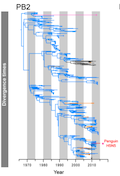Abstract
Avian influenza virus (AIV) surveillance in Antarctica during 2013 revealed the prevalence of evolutionarily distinct influenza viruses of H11N2 subtype in Adélie penguins. Here we present results from the continued surveillance of AIV on the Antarctic Peninsula during 2014 and 2015. In addition to the continued detection of H11 subtype viruses during 2014 in a snowy sheathbill, we isolated a novel H5N5 subtype virus during 2015 in a chinstrap penguin. Gene sequencing and phylogenetic analysis revealed that the H11 virus detected in 2014 had a >99.1% nucleotide similarity to the H11N2 viruses isolated in 2013, suggesting continued prevalence of this virus over multiple years in Antarctica. However, phylogenetic analysis of the H5N5 virus showed that their genome segments were recently introduced into the continent, except for the NP gene that was similar to that in the endemic H11N2 viruses. Our analysis indicates geographically diverse origins for the H5N5 virus genes; with the majority of its genome segments derived from North American lineage viruses, but the neuraminidase gene derived from a Eurasian lineage virus. In summary, we show the persistence of AIV lineages over multiple years in Antarctica; recent introduction of gene segments from diverse regions; and reassortment between different AIV lineages in Antarctica, which together, significantly increases our understanding of AIV ecology in this fragile and pristine environment.
